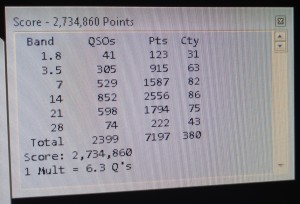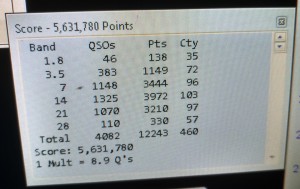I’ve been doing a lot of contest operating the past few years. For the years 2014 and 2015, I’ve operated a combined 19 contests. Additionally, thousands of contest type QSOs were made in casual DX operation from the Cayman Islands as ZF2DX. There is no question that all of that operating time has allowed me to hone my contesting skills. In the past, operating three contests in a year would have been the norm. The rest of my radio time was spent building antennas, running the Cycle 24 business, or just general maintenance tasks around the shack. Cycle 24 is long gone (both the actual cycle and the business) and operating from the N2QV station has allowed me to focus solely on the act of operating.
A second place finish in the 2016 ARRL DX CW contest left me hungry to see if I could perform better in the next big contest. WPX CW offers some interesting strategies to consider. Off time and optimization of six point contacts on the low bands are the main factors in posting a competitive score. For years, the WPX contests have been considered a one radio affair. A look at participants logs will show you that many (but not all) single ops just run, run, run, for the entire contest and give little attention to the second radio. Why bother when a WU2 prefix is just as valuable as a 5H3 prefix, right? Wrong, there are several hundred contacts that can be made throughout the course of the 36 hours that in the end add up to a significant amount of points and mults. The optimum strategy would be to mix traditional SO2R with duel CQing. Unfortunately, the setup at N2QV is not optimal for duel CQing. I would just have to utilize the second radio the old fashioned way, by tuning the dial and finding people to work.
Thankfully, for the WPX contest I would have a dial to tune. For ARRL DX CW I used a mouse wheel for the entire 48 hours to tune the second radio. While that may sound like torture, it actually was user friendly and had little impact on my final score. Scott, WU2X, had time to perfect his Radio Remote Link (RRL) software that allowed my TS 590S to fully control the TS 590S at the N2QV station. S meter, knobs, RIT, etc. were all 100% functional. Very cool considering it was all accomplished by software. In other words no external hardware was needed. Just a USB cable from the 590 to a computer. A simple mouse click on the home screen shortcut and my 590 came to life and immediately went to the frequency of its twin in New York.
I enjoy working out at the gym. 100% weight bearing activities and generally not my legs. I hate doing leg exercises. But in the weeks leading up to the WPX CW contest I decided to try something different. Running. Other than occasionally being forced to run a mile in high school for basketball, I had no experience with long distance running. Keep in mind that high school is now a very distant 20 year memory. My plan was to participate in a local 5K that was set for a week before the WPX CW contest. OK, not participate…. WIN. Yeah, that goal didn’t last long. After my first mile on the treadmill I thought that death was imminent. I ran the mile in about 8.5 minutes and was doubled over on the gym floor. Pathetic. The winning times in our local 5K are generally around 19 minutes. A 5K is 3.1 miles, so the winning time averaged around 6 minutes and 12 seconds per mile! If I’m going to do something then I want to do it 100%, all out. But trying to compete with people that have been running competitively for their entire lives was just unreasonable. I revised my goal to complete the 3.1 miles in under 24 minutes.
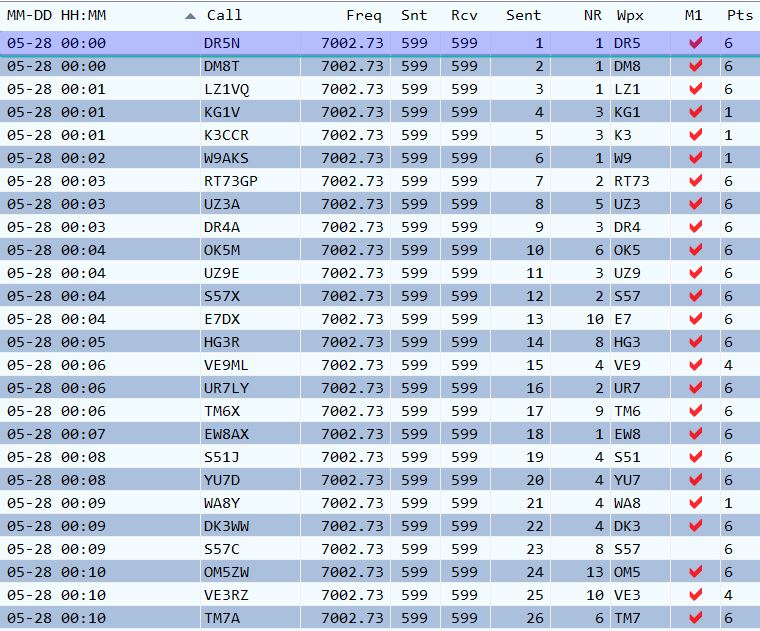
I was supposed to be live for the WPX CW contest. N2QV and WU2X had a project for me to complete at the station in NY. The plan was for me to operate WPX CW and then complete one piece of the new 160 meter antenna. Unfortunately, that didn’t work out so I ended up operating the contest from Arkansas while remotely controlling the N2QV station. The plan was simple, pound 40 meters into submission. The 4/4 stack is killer and with every DX contact adding up to 6 points the band should be easy pickings. I also wanted to have a total of 1200 contacts between 40 and 80 meters and 500 second radio contacts. The second radio goal was a bit lofty, but at the same time it’s only 14 contacts per hour for 36 hours. That sounded doable. I also felt that the single op guys underutilized 80 meters. The trend seems to be to totally neglect 80 meters until the second night. Then spend about an hour CQing there before retreating back to 80 meters. My plan would be to keep the second radio on 80 in order to maximize the double point contacts and also do some brief CQing there in hopes of having all the multi ops find me.
The first 6 hours went by quickly. The first off time occurred at o619 with 739 contacts going into the log. The run radio did not budge from 7002.74 for the entire first operating period. As expected, the Europeans just kept coming and I welcomed them into the log with open arms. Of the 739 contacts that occurred, 512 of those were with Europe and the majority of those came on 40 meters. This did present a problem though. In past WPX contests, I’ve been able to hang with the East coast guys in terms of mults because of all of the U.S. and JA prefixes. Operating from Arkansas allowed me to beam both to the east coast for Europe and to the west coast for JA. However, operating from the East coast doesn’t provide the opportunities to supplement all of the EU prefixes with U.S. and Japanese prefixes. This put even more emphasis on the importance of utilizing the second radio to find mults, even if those mults were only 1 point contacts.
Unfortunately, 80 meters held true to form. I ended the first 6 hours with only 31 contacts on that band. I attempted some brief CQs and second radio stints but the band just didn’t yield anything. 20 meters was also disappointing. Other than a smattering of EU and SA the band was dead. However, there was no doubt that it would come to life when the sun came up. 15 was the big question mark. Conditions had been poor leading up to the contest, and it seemed as if the A & K indexes were improving but it was unclear if it would be enough for 15 to really open into EU. So far the remote had been just OK. There were several times when I adjusted the latency so as to improve the quality of the audio. This is not good though, because all of those lost milliseconds add up over the course of a two day contest. The condition of the HF bands and the remote stability were looming in the back of my mind throughout the contest.
Back on the air at 0926z after a three hour nap. My hopes were high for a big 20 meter run and then transitioning to 15 meters for more of the same. A quick CQ on 14005 netted back to back EU contacts, but the next EU contact would not be for another 20 minutes! Aargh, I was to early to the party. The band simply wasn’t open. I spent time desperately searching for anything on the second radio. OA4SS, WL7E, VK4SN, and VK6LW all went into the log on 40 meters. 20 meters slowly started to wake up and finally around 1000z the band was actually runable. I made a note to myself that I was 30 minutes early. During the 1000z hour, I managed to squeeze in a few second radio Qs on 40 meters with ZM1A and ZF2ET. The 1000Z hour ends with 131 contacts in the log.
ZF2ET (aka K5GO) is operating from the island of Cayman Brac with a single 14AVQ vertical and 100 watts. The antenna is not impressive but his signal is. He has built a small house directly on the water with only salt water between himself and VK, JA, US, and EU. A few antenna upgrades and the station will be highly competitive. The place will also be available to rent, with a full arsenal of radios and amps available for use. Hopefully I can get a family discount and put my Cayman Brac callsign, ZF9DX, to good use.
15 meters still isn’t close to opening. 40 is dead so there is no where to go but to do some in band SO2R work on 20 meters. The amplifier setup and second radio RX antenna (a triband vertical) allows me to tune through 20 meters while also CQing on that band. The rate is declining. The 1100z hour ends with 122 and the 1200z hour ends with 110 contacts going into the log. 15 meters needs to wake up, and fast. I find ED8X on the second radio along with HP1XT and a few South Americans. But still no EU. I put the second radio back on 20 meters and find 4 new contacts within 5 minutes all while maintaining the run frequency on 14004.90. In band SO2R is fun!
At 1349z I take about 1.5 hours off. Back on the air at 1523 and I decide that if 15 is going to keep hitting the snooze button then I’m going to shake it out of its slumber. Surely 24 elements pointed right at EU will be enough to get the band hopping. The 1600z hour ends with 87 contacts going into the log with 65 of those coming from running on 15 meters. The band isn’t great but it allows me to pick off 22 contacts on 20 meters using the second radio. 4Z4AK calls in at 1708z and nine minutes later A60A also calls on 15. The band is open but the activity is sparse. Then at 1725z 4K6FO calls as well. Regardless of the lack of importance of rare prefixes it is enough to keep things interesting and motivating. I bounce back and forth between 15 and 20 meters for the next couple of hours. The rate is not good and I’m just biding my time until 40 meters opens. The first half of the contest ends with 1900 contacts going into the log. 3600 Qs would be a great finishing total. One of the unfortunate aspects of our hobby is the air of mystery regarding who your competition is and how that person is doing. I figure that N2NT and K3CR would be low power. Those two guys are top notch competitors. It’s always possible that K5ZD could decide to put in a full time effort. Like NT and CR, Randy is the cream of the crop. The one guy that I’m confident is my competition is K1LZ. Krassy has a huge station and is a big time operator. Competing with him will take everything that I’ve got. During the 0200z hour the second night while running EU on 80 meters I get the dreaded call from K1LZ. There is a big knot that forms in my stomach in anticipation of hearing his serial number. At least in WPX the competitors are able to easily know how they are doing in terms of contacts. However there are several factors that play into this comparison. We do not know how much off time the other person has used up. We also do not know what the point per QSO of the other station is. K1LZ sends me 5NN 2186. SHIT! I hit the enter key and fire off 5NN 2086. A full 100 contacts behind Krassy. There is nothing to do about it other than to keep pushing and hope that my mult and point total is enough to make up the difference. I doubt at this point that I can close the QSO gap. K1LZ is a run machine and given his location and high fire power advantage I don’t see how I can gain 100 Qs on him.
Nothing is easy the first time you do it. If it is, then it’s probably a drug. My new favorite book is Peak: Secrets from the New Science of Expertise. If you don’t want to read the book then check out the authors research article:
http://projects.ict.usc.edu/itw/gel/EricssonDeliberatePracticePR93.pdf
Here is the gist: innate talent is a myth. How is that for a book summary? If you want to know more then check it out.
My training for the 5K was coming along nicely and it was amazing to see how practice can improve an area of weakness. I was now running up to 4 miles. It sure wasn’t easy but with each session hopping on the tread mill and achieving my goal became easier. Every time there were voices in my head urging me to quit and sometimes I would succumb to those voices. However, I attempted to put the voices on mute and just focus on pushing myself. I loved seeing the sweat fling off my body. The treadmill was drenched and I pitied anyone within the splash zone. The more I ran, the easier it became. The myth of talent certainly jived with my experiences. I’ve managed to become a skilled basketball player, golfer, and contester. And I thoroughly sucked at all of those things for a long time. Only after years of practice did I get to a level where I felt competent in those activities. Running was slowly becoming easier. Although, I had years to go to get to a stage where my times would actually be impressive.
At the half way point of the contest the log contained zero zone 24 or 25 contacts. I had to find some way to tap into these multiplier rich areas of the world. Perhaps there would be a morning run on 20 meters. For now, it was time to milk 40 meters for every last 6 point EU contact. I started running at 2314z on 7012. The 2300z hour finished with 90 contacts with 72 of those coming on 40 meters. A great run in my mind considering it was the second night. The pace continued with 92 contacts at the end of the 0000z hour. During this hour, I managed to find JT5DX on 20 meters on the second radio. A few minutes later TZ5XR calls in on 40 meters. I ask him to repeat his call several times because it doesn’t seem legit. But he insists, so I put him into the log. I then find UN7FW on 20 meters and quickly jump to CQ on 20 meters with the big stack pointed north. I’m hoping to pick up some deep Asia and Russian prefixes with an over the pole run on 20 meters. The move is a bust. Other than 4J4K and RK9F nothing good calls. The second night 80 meter run comes right on que. An hour and a half on 80 nets over 100 contacts with most of those being 6 point EU contacts. I’m aware of lingering on the band after making the mistake in ARRL DX CW, so as the run dies I transition to the band edge on 40 meters. 4L1MA quickly calls in on 40 meters and then A93JA is logged on 20 meters. It’s incredible how well the multiband vertical works as the second radio RX antenna, especially on 20 meters. I pull the plug at 0626z and take a nap. I know that to catch K1LZ I will have to push extremely hard.
I slept a little later knowing that the previous day 20 meters opened about half an hour after I guessed it would. The thought occurs to me that one of the aspects that makes contesting so enjoyable is the unknown variable of the day to day contest conditions. Unfortunately, I get to experience a totally different variable that is related to remote contesting. I’m greeted Sunday morning without the use of my audio program that enables two radio operation. To make matters worse, my local computer is acting like someone has installed a virus in it that’s sole purpose is to drive me nuts. I swap out local computers but still do not have access to the second radio audio. Luckily the remote radio guru, WU2X, is able to quickly fix the problem and I’m back in business. The entire cycle, from problem to solution only lasts about 20 minutes. 20 meters is strong and I decide to not waste an off time. Instead I just lose 20 minutes of operating time.
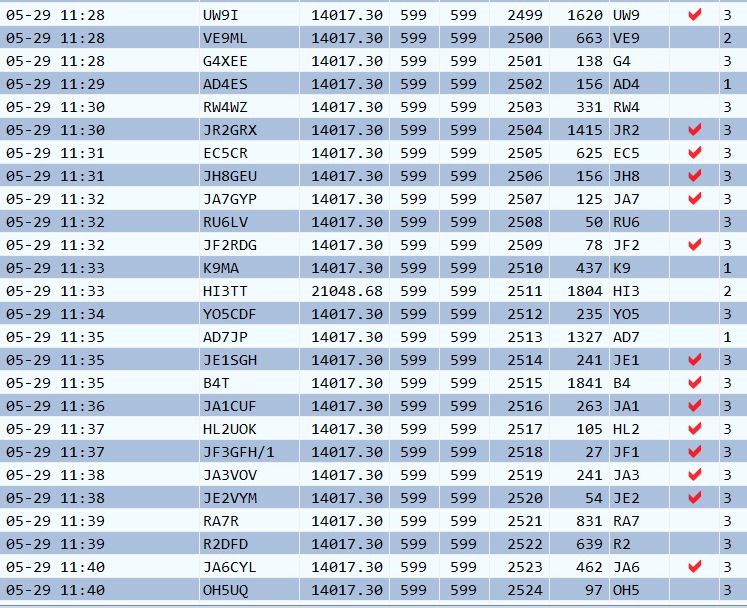
15 meters sounds better the second day! But before leaving 20 I turn the stack to the north and am rewarded with a short run of 12 Asian mults comprised of JA, BY, and an HL contact. The 1200z and 1300z hours are spent with exactly 89 contacts going into the log for both hours on 15 meters. I find VY2TT on 20 meters at 1200z on the second radio. Ken really has this contest figured out and I feel good to have 2550 contacts to his 2685. 7Z1HL calls in at 1158z and then at 1203z K1LZ drops by. I have pulled to within 75 Qs of his score, 2553 vs. 2685. I feel a small dose of accomplishment and keep pushing. At 1315z YD1DTE calls over EU for a nice Asian mult on 15 meters. At 1334z 9J2BO calls in, not Asia, but a mult none the less. A few minutes later FG5LA calls in on my run frequency on 21013.85. All of these contacts from all over the world with the four high stack pointed at EU. The second radio finds some JA stations hiding out high in the band on 20 meters and three consecutive mults go into the log. Nothing much else interesting happens for the next several hours. I follow EU to 20 meters and try to balance off times and rate. I’m hoping that 40 meters is open for one final run. I doubt that 15 will open to JA but I need to somehow improve the paltry JA prefix count. At this point I’ve worked about 15 JA multipliers. 20 continues to produce with my rate hovering between 65 and 80 during the afternoon hours. The 2100 hour shows zero second radio contacts. This is a shame as I’ve undoubtedly left some points on the board.
Finally, at 2239z I find JA3YBK on 15 meters. He is about S1 on the second radio RX vertical. However, when I transmit the big stack kicks in and his signal pops up to S6! I decide to go for broke and find a place to CQ on 15 meters with the four high stack pointed at JA. There is an hour and a half left in the contest and the move is a gamble. 20 meters is consistent with a steady mix of US and EU. 40 meters has the chance to open and provide double point contacts. However, the allure of Asian mults is to much to resist and I QSY to 21005.
Race day! I felt that my training had slacked a bit in the weeks leading up to the race. Instead of running on the treadmill I had gone out to run the actual course. My times were disappointing, usually over 25 minutes. However, I hoped that the actual race would be enough motivation for me to kick into another gear. It took forever for the coordinators to get everyone lined up. I had no intention of making a fast start. Burning all my energy
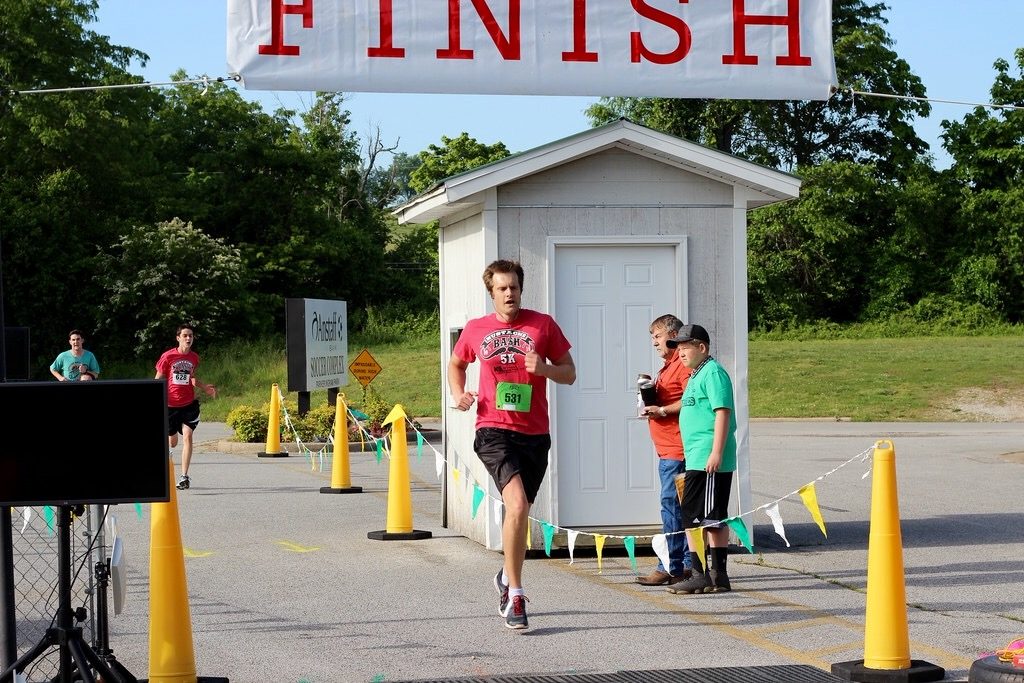
in the first mile would be a bad thing. The leaders quickly said good bye to all of us wannabe runners. But that was fine with me, I was just racing to get under 24 minutes. Like most times I felt great for the first quarter of a mile and ready to quit by the .5 mile mark. But having someone just in front of me was a constant motivator to keep pushing to the end. The 5 K course is in a loop around a small lake in the middle of our town. The runners were told that at the half way mark there would be a sign with our times, but when the half way mark came there was no sign. I hadn’t turned on my running app so I had no way of knowing my time. It didn’t really matter, I just kept pushing and turned on some Jay Z. The last half mile felt great and I pushed hard to finish strong. The finish line was crossed at 23 minutes 21 seconds. Out of 416 participants, I had finished 16th and first in my age group.
The QSY to 15 meters paid off, big time. Over then next hour and a half 35 new mults went into the log. Many JA and BY contacts along with oceania and US west coast comprised the total. The JA stations were all extremely weak. Fortunately, they seemed to be hearing me okay because there was a steady stream up until the end.
The contest finished with just over 11 million points. Despite remote problems due to latency issues, and computer problems due to some rogue virus I was still able to post a claimed score of 11 million points. Just eeking past K1LZ with a slim half million point advantage. I was shocked to see that my mult total and Krassy’s was nearly identical. Some RBN analysis revealed the story. It appears that Krassy split some of his power towards the U.S. in order to attract all of the valuable US mults. A great plan that worked out well for him in terms of his mult count. I was able to garner a small point per QSO advantage that made the difference between our scores. I was also able to trim the QSO difference to a mere 12 contacts. Of course, none of this is official until the final log checking reports are released. Hopefully it will go down as a SOAB high power victo ry via remote operation. I managed to end the contest with 352 second radio contacts, a respectable total. I also was able to nearly achieve the 1200 QSO total between 40 and 80 meters.
ry via remote operation. I managed to end the contest with 352 second radio contacts, a respectable total. I also was able to nearly achieve the 1200 QSO total between 40 and 80 meters.
All of this was made possible by my friends Tariq, N2QV, and Scott, WU2X. Guys like Tim Jellison, KL7WV, do yeoman’s work to keep the big hardware at the station running. Tariq is also blessed with some hard working and knowledgeable locals that can do just about anything around the station. I’m just a lucky guy that gets to play with their toys.

